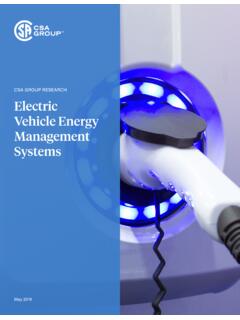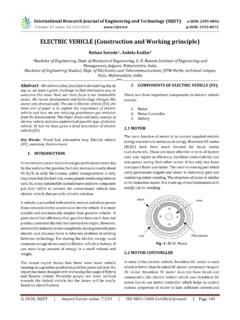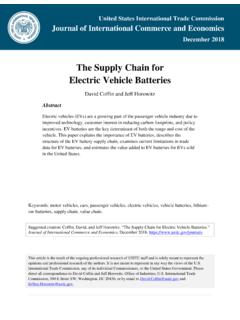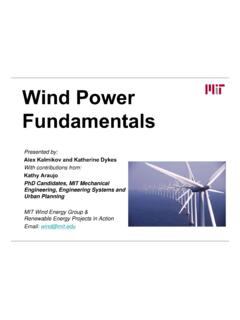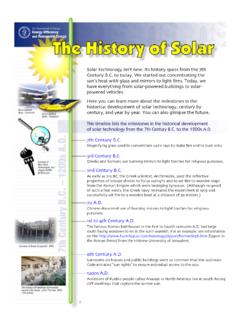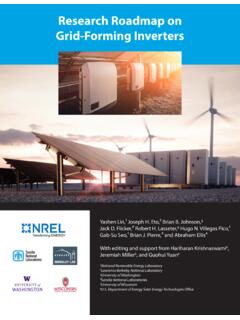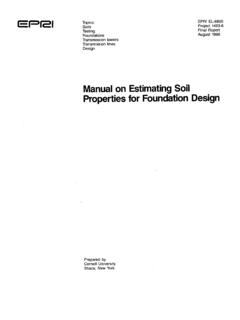Transcription of Electrification & Decarbonization: Exploring U.S. Energy Use …
1 NREL is a national laboratory of the Department of Energy Office of Energy Efficiency & Renewable Energy Operated by the Alliance for Sustainable Energy , LLC This report is available at no cost from the National Renewable Energy Laboratory (NREL) at Contract No. DE-AC36-08GO28308 Electrification & decarbonization : Exploring Energy Use and Greenhouse Gas Emissions in Scenarios with Widespread Electrification and power Sector decarbonization Daniel Steinberg, Dave Bielen, Josh Eichman, Kelly Eurek, Jeff Logan, Trieu Mai, Colin McMillan, Andrew Parker, Laura Vimmerstedt, and Eric Wilson National Renewable Energy Laboratory Technical Report NREL/TP-6A20-68214 July 2017 NREL is a national laboratory of the Department of Energy Office of Energy Efficiency & Renewable Energy Operated by the Alliance for Sustainable Energy , LLC This report is available at no cost from the National Renewable Energy Laboratory (NREL) at Contract No.
2 DE-AC36-08GO28308 National Renewable Energy Laboratory 15013 Denver West Parkway Golden, CO 80401 303-275-3000 Electrification & decarbonization : Exploring Energy Use and Greenhouse Gas Emissions in Scenarios with Widespread Electrification and power Sector decarbonization Daniel Steinberg, Dave Bielen, Josh Eichman, Kelly Eurek, Jeff Logan, Trieu Mai, Colin McMillan, Andrew Parker, Laura Vimmerstedt, and Eric Wilson National Renewable Energy Laboratory Prepared under Task No. Technical Report NREL/TP-6A20-68214 July 2017 NOTICE This report was prepared as an account of work sponsored by an agency of the United States government. Neither the United States government nor any agency thereof, nor any of their employees, makes any warranty, express or implied, or assumes any legal liability or responsibility for the accuracy, completeness, or usefulness of any information, apparatus, product, or process disclosed, or represents that its use would not infringe privately owned rights.
3 Reference herein to any specific commercial product, process, or service by trade name, trademark, manufacturer, or otherwise does not necessarily constitute or imply its endorsement, recommendation, or favoring by the United States government or any agency thereof. The views and opinions of authors expressed herein do not necessarily state or reflect those of the United States government or any agency thereof. This report is available at no cost from the National Renewable Energy Laboratory (NREL) at Available electronically at SciTech Connect Available for a processing fee to Department of Energy and its contractors, in paper, from: Department of Energy Office of Scientific and Technical Information Box 62 Oak Ridge, TN 37831-0062 OSTI Phone: Fax: Email: Available for sale to the public, in paper, from: Department of Commerce National Technical Information Service 5301 Shawnee Road Alexandria, VA 22312 NTIS Phone: or Fax: Email: Cover Photos by Dennis Schroeder: (left to right) NREL 26173, NREL 18302, NREL 19758, NREL 29642, NREL 19795.
4 NREL prints on paper that contains recycled content. iii This report is available at no cost from the National Renewable Energy Laboratory (NREL) at Acknowledgements We would like to thank the following individuals for their thoughtful reviews, comments, and suggestions: David Mooney, Robin Newmark, Gian Porro, Mary Lukkonen, and Karin Haas of the National Renewable Energy Laboratory; Max Wei of the Lawrence Berkeley National Laboratory; Ryan Jones of Evolved Energy ; Carla Frisch, Sarah Garman, and Erin Boyd of the Department of Energy s (DOE s) Office of Energy Policy and Systems Analysis; Steve Capanna, Paul Donohoo-Vallett, Kara Podkaminer, Jack Mayernik, John Stevens, Rachel Nealer, Jacob Ward, and David Gohlke of DOE s Office of Energy Efficiency and Renewable Energy .
5 We would also like to thank DOE s Office of Energy Policy and Systems Analysis for primary funding support for this analysis. In particular, we are grateful to Carla Frisch for her support of this study. This research was funded in 2016 by the Department of Energy under contract number DE-AC36-08GO28308. Any errors or omissions are the sole responsibility of the authors. iv This report is available at no cost from the National Renewable Energy Laboratory (NREL) at Preface This report, funded by the Department of Energy s Office of Energy Policy and Systems Analysis, describes an initial analysis Exploring the potential implications of widespread Electrification of Energy services in the buildings, transportation, and industrial sectors on the future evolution of the electricity system.
6 Given its exploratory nature, the analysis considers only a limited set of Electrification , efficiency, and power sector decarbonization scenarios; in addition, estimates of the Electrification potential of each end-use sector buildings, industry, and transport are based on a relatively aggregated analysis of end-use service and fuel demands by sector and state and, therefore, do not consider explicit technologies, adoption patterns, or other detailed issues that could ultimately affect results. Ongoing and potential future work is designed to apply a suite of higher-fidelity sector-specific models to address some of the same questions as posed in the exploratory analysis. This follow-on work will use a detailed accounting framework of Energy use in all sectors, explore a larger number of Electrification technology options and scenarios, employ high-resolution sector-specific bottom-up engineering models to project future electricity consumption patterns, and conduct detailed electricity system production cost modeling.
7 This study contributes to a considerable body of work at the National Renewable Energy Laboratory that explores the potential for clean Energy and efficiency technologies, along with related research and development, demonstration, and deployment activities and policies, to affect the future evolution and operation of the electricity system. v This report is available at no cost from the National Renewable Energy Laboratory (NREL) at List of Acronyms AEO Annual Energy Outlook ANL Argonne National Laboratory ASHRAE American Society of Heating, Refrigerating and Air-Conditioning Engineers BEV battery electric vehicle BF blast furnace BLAST-V Battery Lifetime Analysis and Simulation Tool for Vehicles BOF basic oxygen furnace CBECS Commercial Buildings Energy Consumption Survey CCUS carbon capture, utilization.
8 And sequestration CH4 methane CO2 carbon dioxide CO2-e carbon dioxide equivalent CPP Clean power Plan CSP concentrating solar power DOE Department of Energy EIA Energy Information Administration EPA Environmental Protection Agency EPRI electric power research institute EPSA Office of Energy Policy and System Analysis EV electric vehicle FCV fuel cell vehicle GHG greenhouse gas GHGRP EPA s Greenhouse Gas Reporting Program GVWR gross vehicle weight rating HDV heavy-duty vehicle HEV hybrid electric vehicle HFC fluorine-containing substance LDV light-duty vehicle MDV medium-duty vehicle M/HDV medium- and heavy-duty vehicles Mt metric ton N2O nitrous oxide NEMS National Energy Modeling System NEVA National Economic Value Assessment NGCC natural gas combined cycle PHEV plug-in hybrid electric vehicle PV solar photovoltaics RECS Residential Energy Consumption Survey ReEDS Regional Energy Deployment System REF Renewable Electricity Futures SEDS State Energy Data System SERA Scenario Evaluation and Regionalization Analysis TEF Transportation Energy Futures vi This report is available at no cost from the National Renewable Energy Laboratory (NREL)
9 At Executive Summary Electrification of end-use services in the transportation, buildings, and industrial sectors coupled with decarbonization of electricity generation has been identified as one of the key pathways to achieving a low-carbon future in the United States. By lowering the carbon intensity of the electricity generation and substituting electricity for higher-emissions fossil fuels in end-use sectors, significant reductions in carbon dioxide emissions can be achieved. This report describes a preliminary analysis that examines the potential impacts of widespread Electrification on the Energy sector. We develop a set of exploratory scenarios under which Electrification is aggressively pursued across all end-use sectors and examine the impacts of achieving these Electrification levels on electricity load patterns, total fossil Energy consumption, carbon dioxide emissions, and the evolution of the power system.
10 Using business-as-usual projections of end-use fuel and service demands as a starting point, we developed scenarios of Electrification for each end-use sector based on exogenously defined rates of Electrification and efficiency improvements for each end-use service. We then employ a highly detailed power sector model to study the impacts of Electrification on the power sector and on greenhouse gas (GHG) emissions. We simulate the evolution of the power system both with and without an assumed power sector cap on GHG emissions of 83% below the 2005 level by 2050. Under the scenarios explored, widespread Electrification of end-use services across the transportation, buildings, and industrial sectors leads to a doubling of electricity consumption by 2050, but moderate improvements in the Energy efficiency of end-use devices can substantially limit the growth in load.










